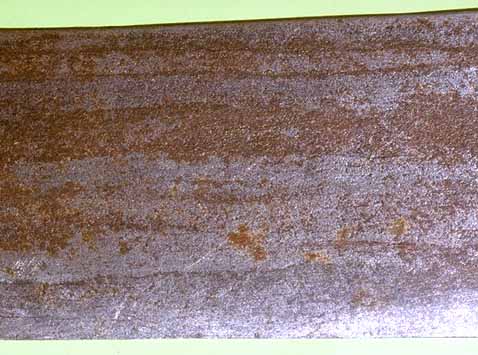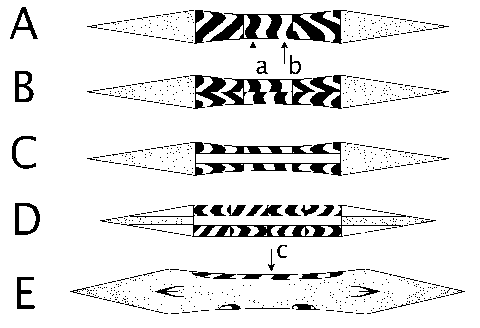| Author |
Message |
Robin Smith

|
 Posted: Wed 06 Jun, 2012 7:46 pm Post subject: "Piled" Construction Posted: Wed 06 Jun, 2012 7:46 pm Post subject: "Piled" Construction |
 |
|
In Early Medieval blades said to be of "piled" construction, what is the orientation of the piling? Is it usually parallel to the edge or perpendicular to it?
To be clear here, I am talking only late "viking age" and early medieval swords, not Celtic or other age, and I am only talking "piled" not pattern welded (even though PW is obviously a type of piling).
A furore Normannorum libera nos, Domine
|
|
   |
 |
|
Scott Woodruff
|
 Posted: Wed 06 Jun, 2012 10:01 pm Post subject: Posted: Wed 06 Jun, 2012 10:01 pm Post subject: |
 |
|
I suppose it is possible to forge your piled bar into a square section and then flatten it so that the layers are perpendicular, but I do not know of any blades with this construction. Generally, early medieval/viking age forge welds had major slag inclusions, and having the weakness running parallel there is less danger of catastrophic failure than if one were to have them perpendicular.
Last edited by Scott Woodruff on Thu 07 Jun, 2012 10:20 am; edited 1 time in total
|
|
  |
 |
Robin Smith

|
 Posted: Wed 06 Jun, 2012 10:24 pm Post subject: Posted: Wed 06 Jun, 2012 10:24 pm Post subject: |
 |
|
Thanks...
Just to be clear, I mean parallel to the plane being created by the blade, and perpendicular I mean still running lenghtwise with the blade but perpendicular to the plane of the blade.
For example here is a blade that clearly has perpendicular piles

But this is NOT a viking/medieval sword, but an Indian sword
However here is a reconstruction a metallurgical cross section of a seax and 9th C sword that seem to show the opposite (parallel piling)

Which is correct for this period? I would think the 9th C would be right, but a quote I read from Peter J lead me to think otherwise. But then again the quote is in referrence to Celtic swords, so...
Also, the welding in some Pattern Welded blades are perpendicular to the plane of the blade (A and B). Some have both perpendicular and parallel piling (C and D)

Sorry for not being clear. I am just unsure as to what is meant when they say "piled construction" in relation to late viking/early medieval swords. Is it just about any form of layered construction including sandwich style construction, or is it specifically the perpendicular construction similar to a straight pattern weld you see on Celtic and Roman swords?
A furore Normannorum libera nos, Domine
|
|
   |
 |
|
Peter Johnsson
Industry Professional
|
 Posted: Thu 07 Jun, 2012 1:29 am Post subject: Posted: Thu 07 Jun, 2012 1:29 am Post subject: |
 |
|
Piled construction is a natural result of refining the steel by repeated folding and welding. You might say that all steel from before bessemer process is piled. The shear steel used for the trapper knives in the colonization of America was of piled construction.
Sometimes the layers are arranged so that they are at right angels to the cutting edge. This is, I think, made to show a bit like pattern welding is used both for aesthetic effect and at the same time tells you something about the skill of the smith, or the quality of the material.
This used of piled structure belongs to the celtic and roman iron age, perhaps with some exceptions?
In the diagrams you posted about, showing cross section of pattern welded blades, what you interpret as piled steel in the middle of the blade is in fact pattern welded. This is what a cut through a pattern welded blade looks like, or at least, it is how it is often represented in pedagogical drawings. In reality the direction of the layers in the pattern welded panels are much less well ordered and normally slant at different directions. That is why you were led astray I think. You were tripped by the well meaning of the one who made the drawing, who probably only wanted to make the situation more clear.
Piled construction of steel means there are clear layers to be seen in the structure, that bears witness of its composite or folded nature. It *can* be a decorative effect, but that to my knowledge belongs to the periods before the viking age. Piled structure is typically found in the edges of viking swords. It is a subtle effect, quite unlike the pattern in the mid panels or the core.
|
|
   |
 |
Robin Smith

|
 Posted: Thu 07 Jun, 2012 5:54 am Post subject: Posted: Thu 07 Jun, 2012 5:54 am Post subject: |
 |
|
Thank you! I was hoping you would weigh in. That nakes sense that basically all pre-bessimer steel is piled..
A furore Normannorum libera nos, Domine
|
|
   |
 |
Craig Johnson
Industry Professional

|
 Posted: Thu 07 Jun, 2012 5:57 am Post subject: varied structures Posted: Thu 07 Jun, 2012 5:57 am Post subject: varied structures |
 |
|
I would add to Peter's excellent description above that the variables in the way smiths put together the material to make the blades from and the smiths forming the blades would not all use the same methods to craft their products. You will see several different methodoligies used to structure the blades and each of these would have a tendency to be a form of piled construction.
Williams articles and books touch on this well as does some of the work of Tylecote.
Best
Craig
|
|
    |
 |
|
|

